Tutorial
What Is an Acceptable Plagiarism Percentage?
You've seen the report, and there's a percentage staring back at you. What does it actually mean? Is it good? Is it bad?
While there's no single magic number, a good rule of thumb for most academic work is to stay below 15%. Think of this score as 'background noise' in a conversation. A little is unavoidable—common phrases, technical terms, citations—but too much drowns out your original voice. Context, however, is everything. That 15% isn't a universal law.
Understanding Plagiarism Percentage Thresholds
Let's clear something up right away: that percentage isn't a grade. It’s a similarity index. It’s simply a measure of how much text in your document matches text in a massive database of books, articles, and websites.
A low score doesn’t automatically mean your work is perfect, and a slightly higher one doesn’t always signal academic dishonesty. It’s all about why the text was flagged. Properly formatted quotes, common industry jargon, and your bibliography can all add to the percentage. The number itself is just a starting point; the real work is in the interpretation.
Why Context Matters So Much
Different fields, different rules. What flies in a high school paper is worlds away from the expectations for a doctoral dissertation or a corporate white paper. Each arena has its own unwritten (and written) rules for originality and attribution.
This image really drives home how these "acceptable" percentages can shift across academic, publishing, and corporate worlds.
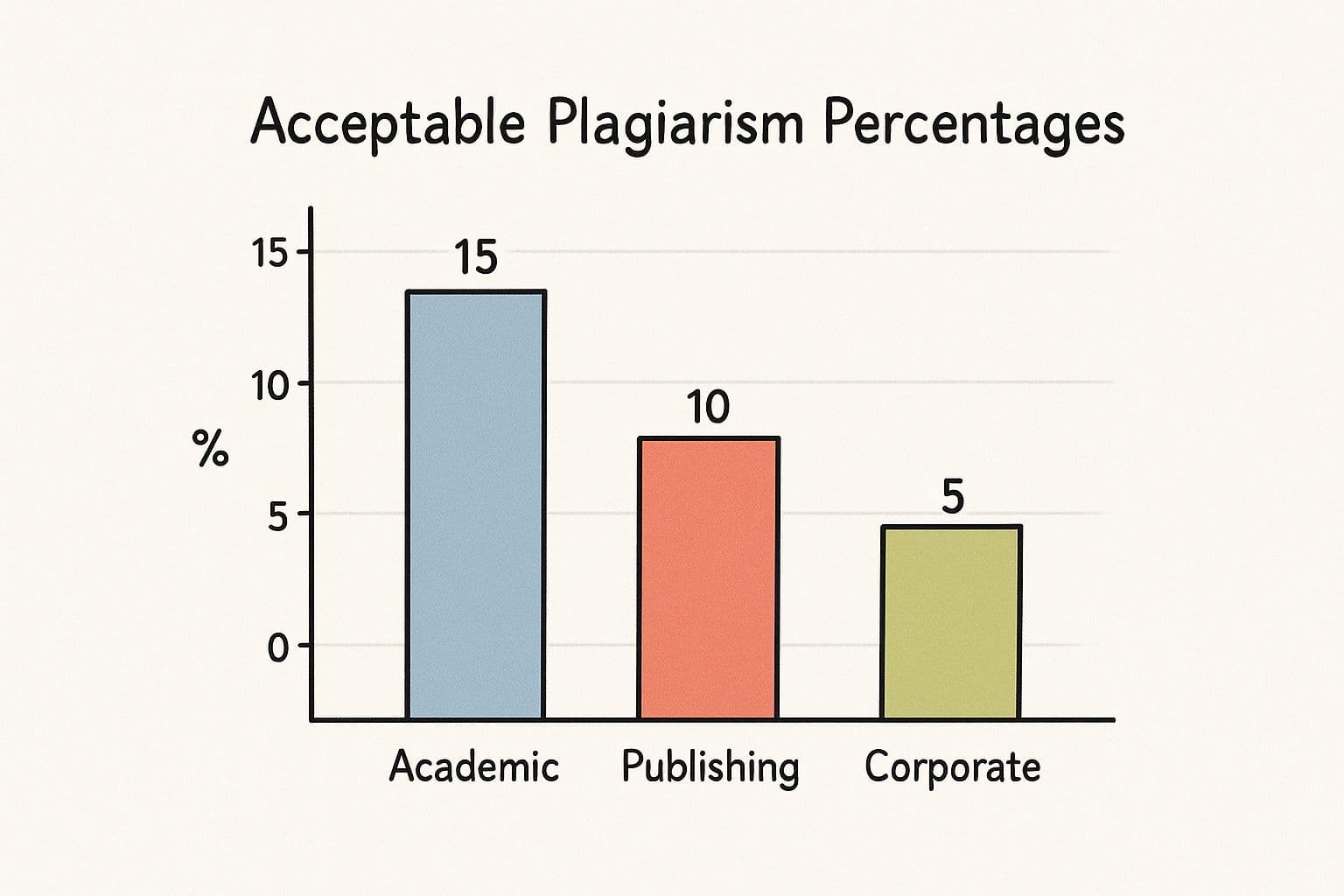
As you can see, the demand for absolute originality gets much stricter as you move from the classroom to the professional publishing world. The stakes are simply higher.
In academic circles, that 15% threshold is a widely used benchmark. Anything below that is often chalked up to unintentional overlap or the quirks of the detection software, rather than deliberate copying. For a deeper dive into how universities view these scores, you can find some great insights on plagiarism percentages at PapersOwl.com.
To make this even clearer, here's a quick reference table showing how these numbers can vary depending on what you're writing.
Acceptable Plagiarism Percentages by Content Type
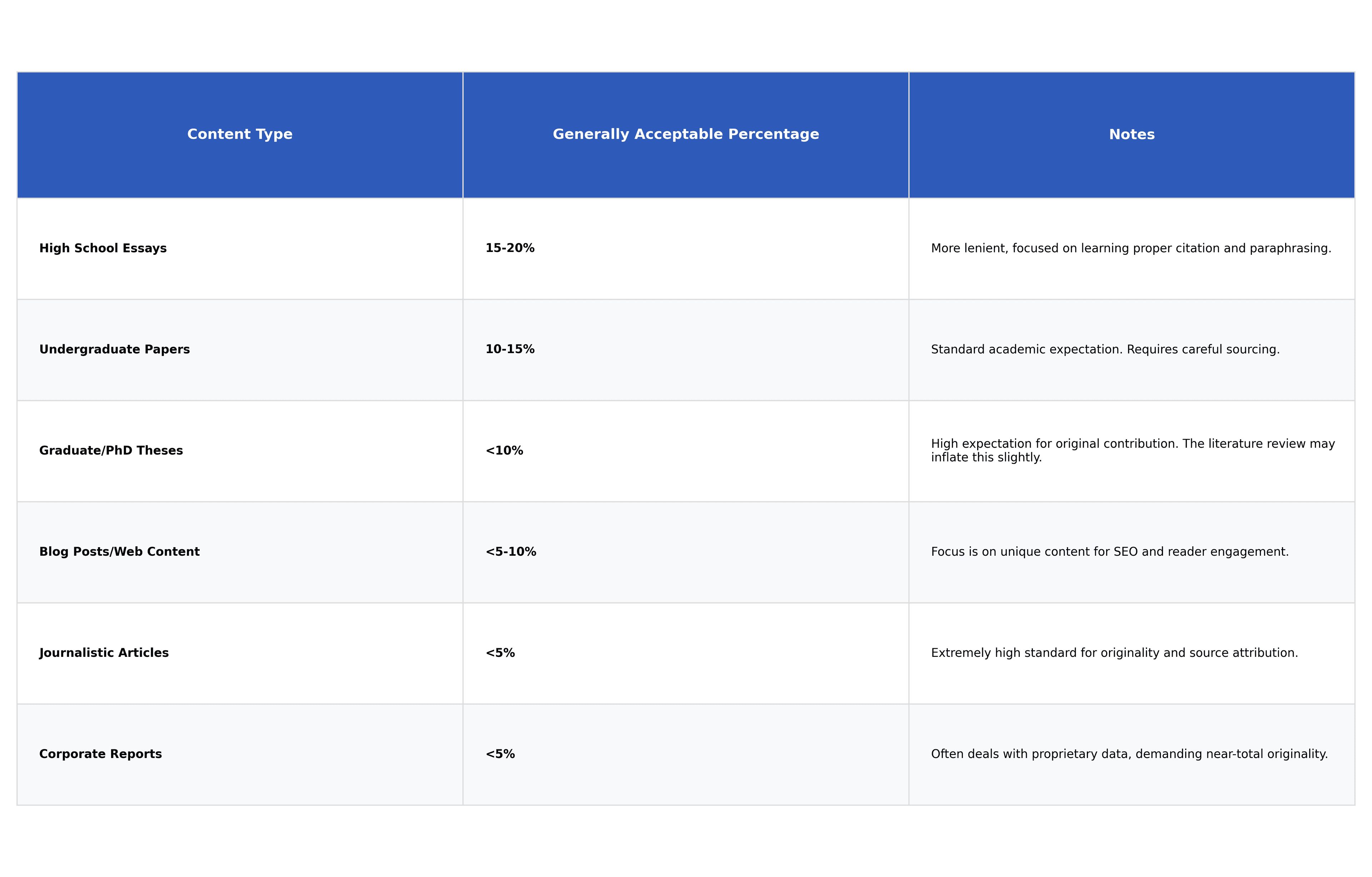
Remember, these are just guidelines. The best course of action is always to check the specific requirements from your professor, publisher, or company. When in doubt, aim for the lowest percentage possible.
Why a Zero Percent Score Is a Myth
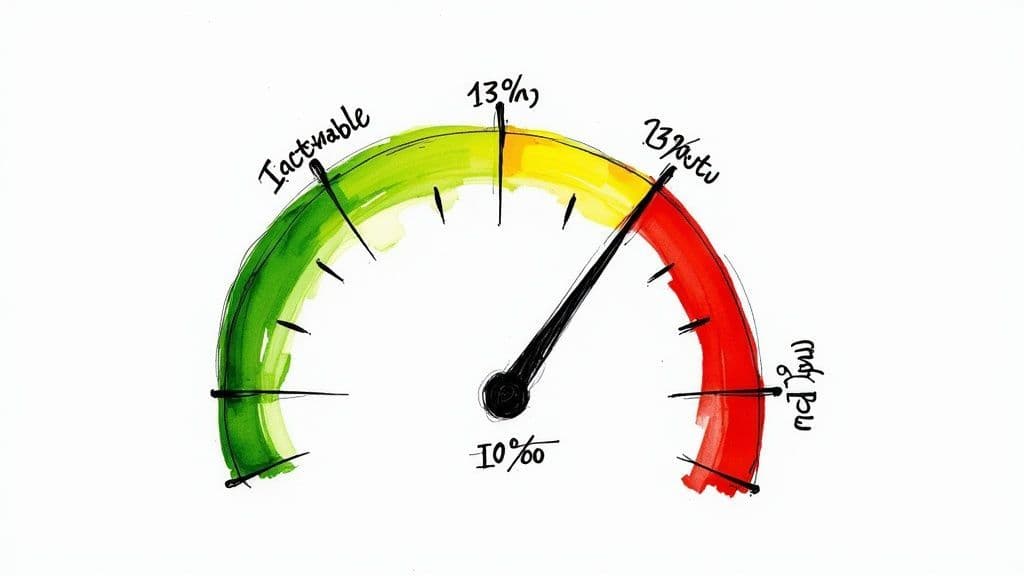
Let’s get one thing straight: aiming for a 0% plagiarism score is a fool's errand. Not only is it basically impossible, but it also shows a fundamental misunderstanding of how tools like Turnitin actually work.
These programs aren't "plagiarism detectors" in the way a metal detector finds metal. They're much more like a search engine—incredibly powerful text-matching software designed to find similarities, not to judge your intentions.
Think of it like trying to bake a cake without using any common ingredients like flour or sugar. It’s just not going to happen. In the same way, all writing, especially academic or professional work, builds on existing knowledge. This naturally creates some overlap that the software will flag.
What Are False Positives in Plagiarism Reports?
When you get your similarity report back, it can be cluttered with matches that are perfectly fine but still pump up your percentage. These are called "false positives." They aren't signs of cheating; they're just the byproducts of a scanner doing its job a little too well.
> The goal isn't an impossible score of zero. It's about learning to read the report, figure out which matches matter, and see which ones are just background noise.
So, what kind of harmless stuff gets flagged all the time?
* Properly Cited Quotes: You did everything right—quotation marks, attribution, the whole nine yards. The software will still flag it as matched text because, well, it is.
* Bibliographies and Reference Lists: Your list of sources is supposed to match the original publications. If it didn't, you'd have a bigger problem.
* Common Phrases and Terminology: Every field has its jargon. Phrases like "return on investment" or "qualitative data analysis" are going to get flagged because they're used everywhere.
Seeing a score above zero is completely normal and even expected. The real skill is shifting your focus from chasing an impossible number to intelligently interpreting what the report is telling you. Make sure the flagged content is the "good" stuff—the quotes and references—not huge chunks of unattributed text. A healthy, low score that shows original thought supported by well-cited research is what you're actually after.
How Plagiarism Standards Change with Academic Level
The rules for what counts as "acceptable" plagiarism aren't set in stone. They shift quite a bit as you move up the academic ladder.
Think of it like learning to drive a car. When you're just starting out with a learner's permit, the instructor is happy if you just stay in your lane and use the blinker. It's the same for undergraduates—the main goal is learning the fundamentals of research, like how to properly synthesize sources and paraphrase ideas without messing it up.
Because there's a learning curve, instructors are often a bit more lenient with undergrad papers. They're more focused on teaching good citation habits than on penalizing every single minor overlap. The emphasis is squarely on building a solid foundation for academic integrity.
Raising the Bar for Graduate Students
Things get a whole lot stricter at the graduate level. For master's or Ph.D. students, the game completely changes. You're no longer just reporting on what others have said; your mission is to contribute new, original ideas to your field.
The training wheels are officially off. The expectation for near-perfect originality is incredibly high.
> A thesis or dissertation is a student's entry into the academic conversation as a creator of knowledge, not just a consumer. Therefore, the tolerance for unoriginal text, even if accidental, shrinks to a bare minimum.
This is why even a tiny percentage of uncited text gets put under a microscope. The data backs this up, showing a big difference in plagiarism rates between academic levels. While undergrad rates can be all over the place, grad students are held to a much tougher standard.
For instance, some studies have found that around 27% of master's theses have instances of plagiarism. In certain STEM fields, research proposals have hit similarity rates as high as 42.6%. You can dig into more of these academic integrity statistics at SaaSworthy.com.
This jump in standards makes sense. A graduate student's work is supposed to be a pillar of original thought that future researchers can build on. A low similarity score isn't just a box to check—it's proof of the author's unique contribution to their discipline.
How to Read and Interpret a Similarity Report
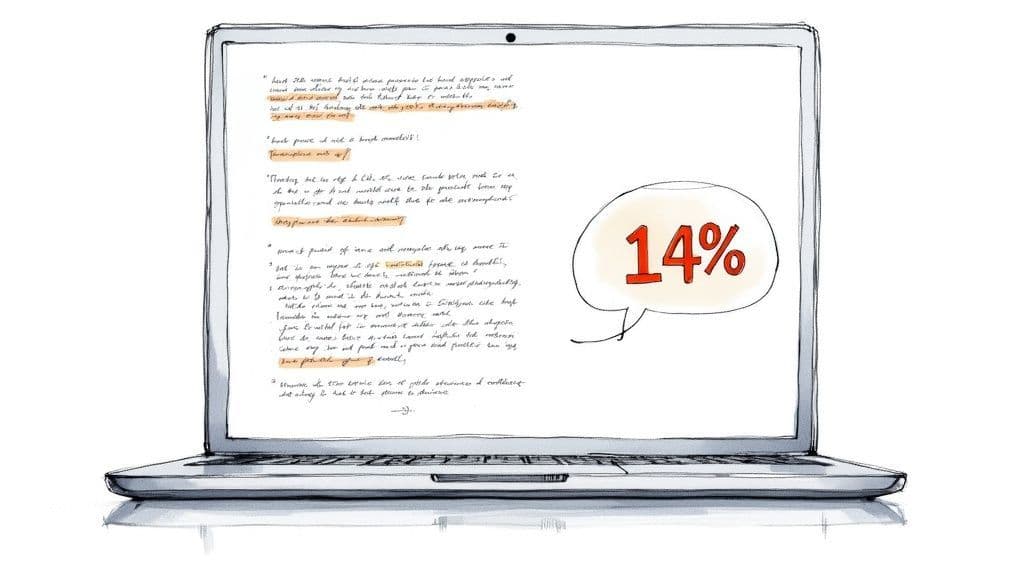
Seeing a high percentage on a similarity report can definitely make your heart sink for a moment. But that number almost never tells you the whole story. Before you panic, take a breath and learn to analyze the report the way an instructor would—by looking past the final score to see what's really going on.
Think of that report less like a final grade and more like a diagnostic tool. It's there to show you where your writing overlaps with other sources, giving you the perfect chance to polish your work. The real skill is learning to tell the difference between a harmless match and a genuine problem.
Look Beyond the Final Percentage
First things first: ignore that big, scary percentage at the top and dive straight into the color-coded details. Plagiarism checkers like Turnitin or Grammarly highlight the exact phrases and sentences that match their databases. Your job is to play detective and figure out why each part got flagged.
Here’s what a typical report looks like. You can see the highlighted text in the document and the corresponding sources listed off to the side.

This kind of breakdown lets you trace every single match back to its origin, which is crucial for figuring out what needs fixing.
Use our Free AI Detector to check your content
As you go through the highlighted text, ask yourself a few key questions:
* Is it a properly cited quote? If the text is wrapped in quotation marks and you've attributed it correctly, that's a "good" match. It just shows you’re using your source material.
* Is it a common phrase or industry term? Things like "qualitative data analysis" or other standard expressions often get flagged. This is totally normal and not plagiarism.
* Is it part of your bibliography or reference list? Your bibliography is supposed to match published works, so of course it will be highlighted. These are expected matches.
> The real concern isn't whether you have matches, but what kind of matches they are. A report with a 15% score that's just small, scattered common phrases is way less of an issue than a 10% score caused by one big, unattributed paragraph.
Your main targets are the big chunks. Large blocks of highlighted text that aren't quoted or cited are the red flags that need your immediate attention. These are the spots where you either need to add a proper citation or do a much better job of paraphrasing to get within a safe plagiarism percentage.
Plagiarism Rules in the Professional World
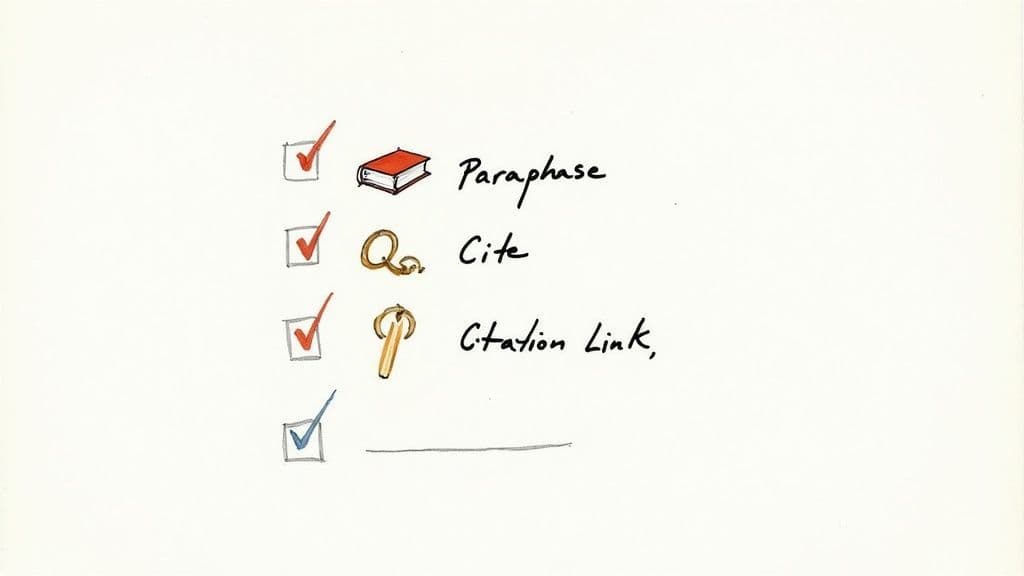
If you think originality is just an academic hurdle, think again. It’s the absolute cornerstone of professional credibility. Once you step out of the classroom, the goalposts for an acceptable plagiarism percentage don't just move—they get bolted to the ground. The consequences for crossing the line can ding your career and tarnish your reputation for good.
Take fields like journalism and publishing. The tolerance for plagiarism is basically zero. Here, originality isn't just an ethical high ground; it's legally protected by copyright law and is the bedrock of reader trust. Even one tiny snippet of unattributed text can lead to a full-blown retraction, legal headaches, and career-ending damage.
Content Marketing and Online Media
The world of content marketing and blogging plays by slightly different rules, but the core principle is the same. Pulling in information and quoting experts is not only normal but often encouraged. The bright red line between smart curation and outright plagiarism, however, is attribution. You have to credit your sources, clearly and consistently.
For anyone creating content online, there's another beast to worry about: duplicate content. While it’s not academic plagiarism in the traditional sense, publishing text that’s identical or way too similar to what’s already out there can absolutely tank your website's search engine rankings. Google and other search engines want to show their users unique, valuable stuff, not the same article copied and pasted a dozen times.
> The real difference comes down to intent and impact. In academia, plagiarism is about intellectual honesty. In SEO, duplicate content is about providing the best user experience and not trying to game the system. But the solution to both? Be original.
At the end of the day, professional standards demand that you bring your own unique value to the table. Whether it's an article, a blog post, or a piece of marketing copy, the mission is always to produce original work that builds your authority and respects everyone else's intellectual property.
The explosion of AI tools has thrown a new wrench into things, sparking a huge conversation about how to maintain integrity. We dive deeper into this very topic in our article about students getting in trouble for using AI writing.
Proven Strategies to Reduce Your Similarity Score
Knowing the magic number for an "acceptable" plagiarism percentage is half the battle. Actually keeping your similarity score in the green zone? That takes a real game plan.
This isn't about quick fixes after the fact. It’s about building originality into your writing process right from the jump. Think proactive habits, not reactive panic.
Your best weapon against a high similarity score is mastering the art of paraphrasing. And I don't mean just swapping out a few words for synonyms. That old trick is called "patchwriting," and modern plagiarism checkers see right through it.
Real paraphrasing means you actually get the original idea, process it, and then explain it completely in your own words and sentence structure.
> The point of paraphrasing isn't just to dodge a plagiarism flag. It's to prove you actually understand the material. You're showing that you can weave other people's ideas into your own argument.
Imagine explaining a wild movie plot to a friend. You wouldn't just recite the script verbatim. You'd hit the key events, explain what drives the characters, and sum up the main themes—all in your own words to make it click. That's paraphrasing.
Beyond Paraphrasing: Proactive Writing Habits
Paraphrasing is your bread and butter, but a few other habits will seriously drive down your score.
Synthesis is a big one. Instead of leaning on just one source for an entire paragraph, pull insights from several. Weave them together to build a new, stronger point that is entirely your own creation.
And, of course, mastering citations is absolutely non-negotiable. Every field has its go-to style, whether it’s APA, MLA, or Chicago. Learn the rules for your discipline's in-text citations and reference lists. This ensures that even when you quote someone directly, you're giving them credit and making it crystal clear where their voice ends and yours begins.
Here are a few simple steps to bake into your process:
* Take Notes in Your Own Words: When you're researching, resist the urge to copy-paste. Right from the start, summarize the important stuff in your own shorthand.
* Cite as You Go: Don't save citations for the end. The second you drop in a quote or a paraphrased idea, add the citation. You'll thank yourself later.
* Use a Plagiarism Checker as a Tool: Run your draft through a checker before you submit it. The report isn't a judgment; it's a guide showing you which spots might need better paraphrasing or a clearer citation. For more tips, check out our guide on [how to not get caught plagiarizing](https://www.stealthgpt.ai/blog/how-to-not-get-caught-plagiarizing-in-the-new-year).
Most universities are cool with a similarity score below 15%–20%. Creep past that line, especially without solid citations, and you’re likely to attract unwanted attention. You can dig into more plagiarism statistics on PlagiarismSearch.com. By making these habits second nature, you can stop worrying about the number and focus on writing great work.
Still Have Questions About Plagiarism?
Let's dig into some of the most common questions that come up when you're staring at a similarity report and trying to make sense of the numbers.
Will I Get Flagged for Self-Plagiarism?
You bet. It's a common misconception, but resubmitting work you've already turned in—even if it's your own—will almost always get flagged by detection software.
Most schools and universities see this as a form of academic misconduct. Before you even think about recycling a paper from another class, check your institution's policy. It’s better to be safe than sorry.
Are High Scores on Quotes a Problem?
Usually, no—as long as you’ve cited them perfectly according to the required style guide (like APA, MLA, or Chicago). The software is just doing its job by highlighting matched text.
But here's the catch: an instructor can still knock points off your grade for over-relying on quotes. If your paper is just a string of quotations with a few of your own words sprinkled in, it doesn't show you actually understand the material. It's not technically plagiarism, but it's not good writing, either.
Do I Really Need to Cite Common Knowledge?
Nope, you don't. Common knowledge refers to facts that are widely accepted and can be found in a bunch of general sources. Think "The Earth revolves around the Sun" or "Paris is the capital of France." No citation needed for those.
The line can get a little blurry, though, so when in doubt, just add the citation. The rise of AI writers has also thrown a wrench in things; for more on that, check out our guide on what percentage of AI writing is acceptable to stay out of trouble.
---
Ready to make sure your writing is 100% original and sounds completely human? The StealthGPT AI Humanizer can transform your text to fly past AI detectors, all while keeping a natural, polished tone. Try it free at https://stealthgpt.ai.